Subaru WRX (2021 year). Manual in english — page 16
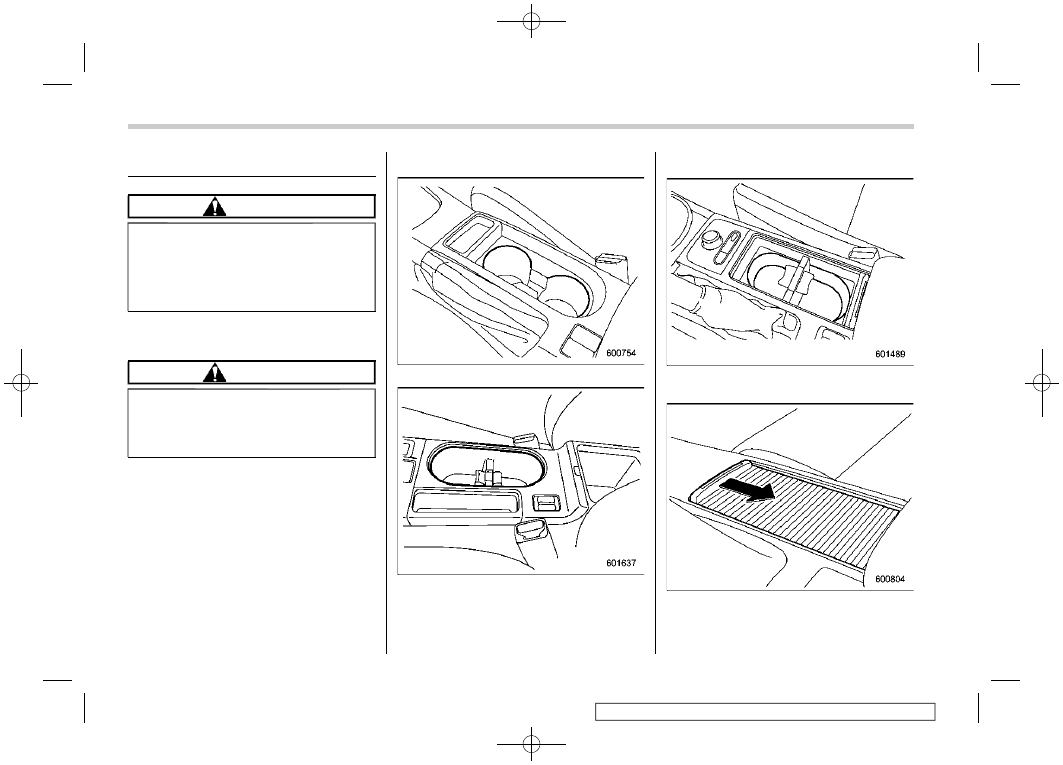
(252,1)
Cup holders
CAUTION
Take care to avoid spills. Beverages,
if hot, might burn you and/or your
passengers. Spilled beverages may
also damage upholstery, carpets or
audio equipment.
&
Front passenger’s cup holder
CAUTION
Do not pick up a cup from the cup
holder or put a cup in the holder
while driving. Doing so can distract
you and lead to an accident.
!
Except STI
Type A
Type B
A dual cup holder is built into the center
console.
!
STI
The dual cup holder is built into the center
console near the parking brake lever.
To access the cup holder, pull the lid
toward the rear.
Interior equipment/Cup holders
6-6
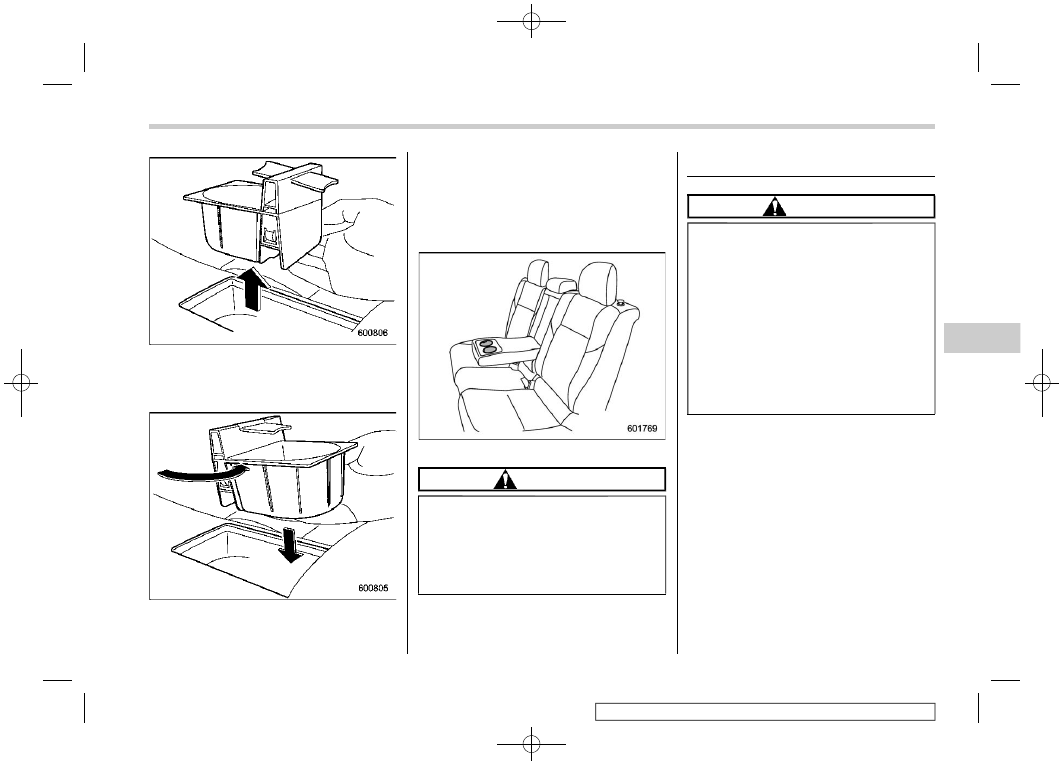
(253,1)
You can pull out the divider in the cup
holder and insert it in a different position
(further toward the front or rear) to enable
cups of different sizes to be held.
NOTE
With the divider taken out, you can use
the cup holder as a storage box.
&
Rear passenger’s cup holder
A dual cup holder is built into the armrest.
CAUTION
When a cup containing a beverage is
in the cup holder, do not fold down
the rear seats. Otherwise, the bev-
erage could spill while driving, and if
the beverage is hot, it could burn
you and/or your passengers.
Bottle holders
CAUTION
.
Do not pick up a bottle from the
bottle holder or put a bottle in the
holder while driving. Doing so
can distract you and lead to an
accident.
.
When placing a beverage in a
bottle holder, make sure it is
capped. Otherwise, the beverage
could spill when opening/closing
the door or while driving and, if
the beverage is hot, it could burn
you and/or your passengers.
– CONTINUED –
Interior equipment/Bottle holders
6-7
6
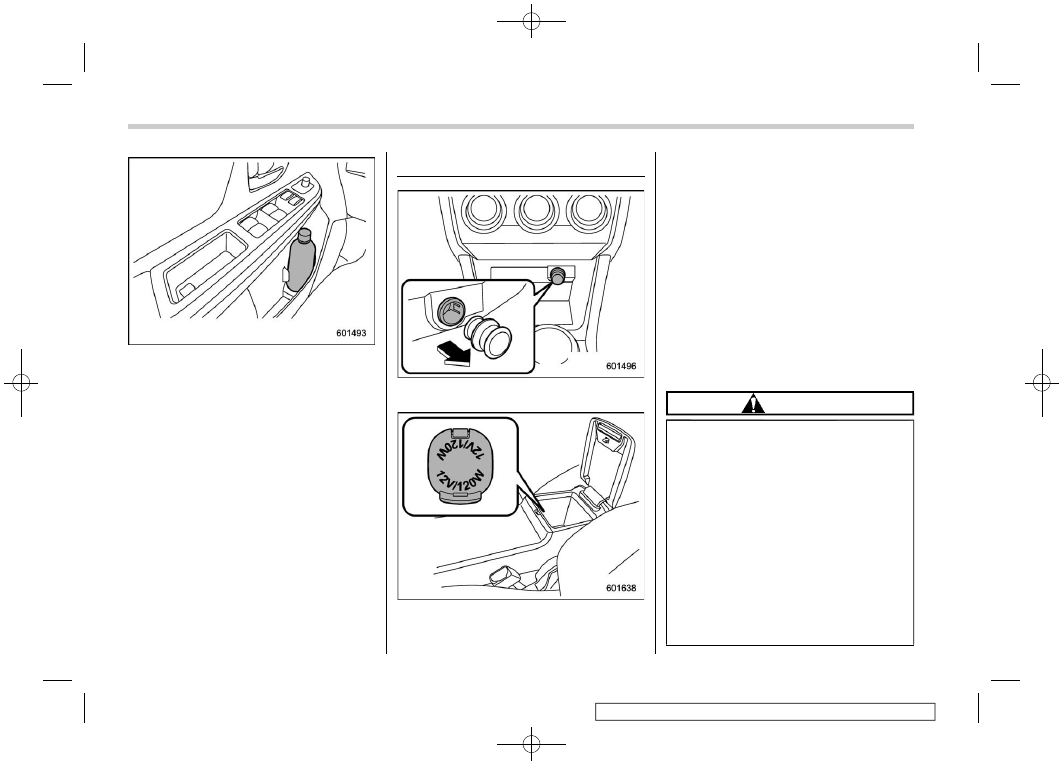
(254,1)
You can use the bottle holder equipped on
each door trim to hold a beverage bottle
and other items.
Accessory power outlets
Power outlet below the climate control
dials
Power outlet in the center console
Accessory power outlets are provided
below the climate control dials and in the
center console. Electrical power (12 V DC)
from the battery is available at any of the
outlets when the ignition switch is in either
the “ACC” or “ON” position.
You can use an in-vehicle electrical appli-
ance by connecting it to an outlet.
The maximum power rating of an appli-
ance that can be connected is
120 W
. Do
not use an appliance which exceeds the
indicated wattage for each outlet.
When using appliances connected to two
or more outlets simultaneously, the total
power consumed by them must not ex-
ceed 120 W.
CAUTION
.
Do not attempt to use a cigarette
lighter in the accessory power
outlets.
.
Do not place any foreign objects,
especially metal ones such as
coins or aluminum foil, into the
accessory power outlet. That
could cause a short circuit. Al-
ways put the cap on the acces-
sory power outlet when it is not in
use.
.
Use only electrical appliances
which are designed for 12 V DC.
The maximum power rating of an
Interior equipment/Accessory power outlets
6-8
(255,1)
appliance that can be connected
is 120 W. Do not use an appliance
which exceeds the indicated wat-
tage for each outlet.
When using appliances con-
nected to two or more outlets
simultaneously, the total power
consumed by them must not
exceed 120 W. Overloading the
accessory power outlet can
cause a short circuit. Do not use
double adapters or more than
one electrical appliance.
.
If the plug on your electric appli-
ance is either too loose or too
tight for the accessory power
outlet, this can result in a poor
contact or cause the plug to get
stuck. Only use plugs that fit
properly.
.
Use of an electric appliance in the
accessory power outlet for a long
period of time while the engine is
not running can cause battery
discharge.
.
Before driving your vehicle, make
sure that the plug and the cord on
your electrical appliance will not
interfere with your shifting gears
and operating the accelerator
and brake pedals. If they do, do
not use the electrical appliance
while driving.
&
Use with a cigarette lighter (if
equipped)
To use the accessory power outlet as a
cigarette lighter socket, purchase the
cigarette lighter plug, which is an optional
accessory. A cigarette lighter plug is
available from your SUBARU dealer.
The cigarette lighter operates only when
the ignition switch is in the “ON” or “ACC”
position.
To use the cigarette lighter, push in the
knob and wait a few moments. It will
automatically spring up when ready for
use.
WARNING
To avoid being burned, never grasp
the lighter by the end with the
heating element. Doing so could
result in injury and could also da-
mage the heating element.
CAUTION
.
Do not hold the lighter pushed in,
because it will overheat.
.
The electrical power socket is
originally designed to use a gen-
uine SUBARU cigarette lighter
plug. Do not use a non-genuine
cigarette lighter plug in the sock-
et. Doing so may cause a short-
circuit and overheating, resulting
in a fire.
.
If the socket is ever used for a
plug-in accessory such as a cell
phone, that may damage the
portion of the socket’s internal
mechanism that causes a cigar-
ette lighter plug to “pop out” after
its lighter element is heated.
Therefore, do not place a cigar-
ette lighter plug in a socket that
has been used, even once, to
power a plug-in accessory. Doing
so may cause the plug to stick
and overheat, creating a potential
fire hazard.
Interior equipment/Accessory power outlets
6-9
6
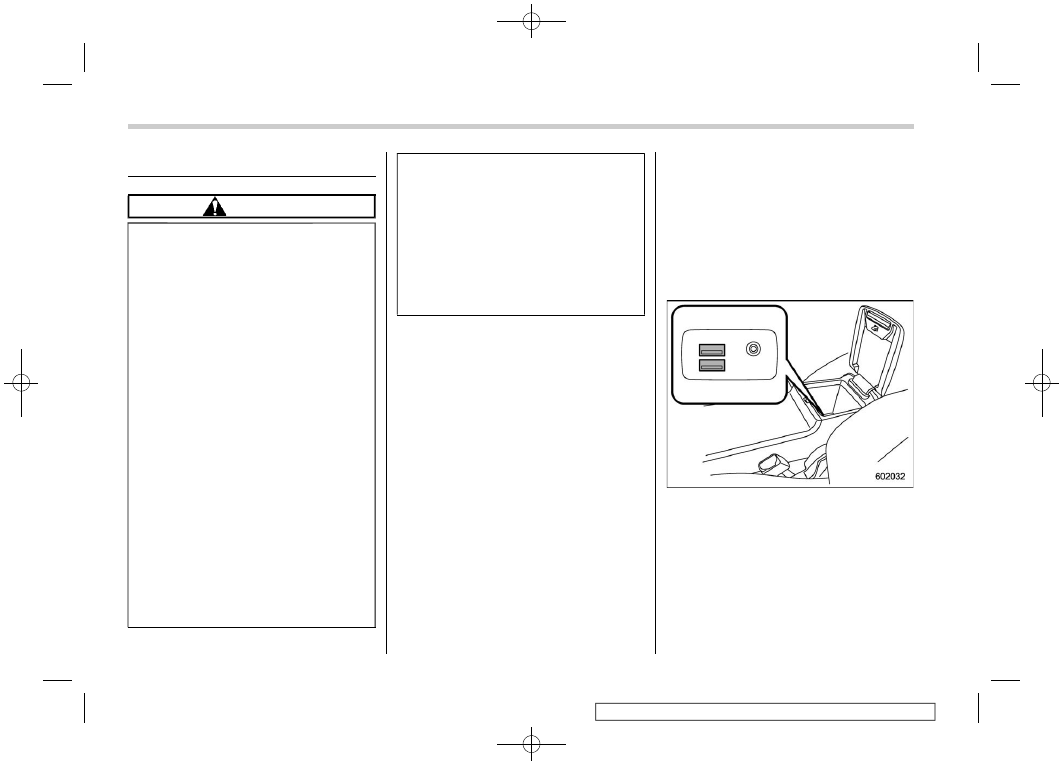
(256,1)
USB power supply
CAUTION
.
The specification of a USB term-
inal that can be used is the A-
type. If a different specification of
terminal is connected, power
supply or charging may not be
possible, or the device may mal-
function.
.
There is a risk that a connected
device may malfunction or data
may be damaged. The connec-
tion of a device shall be per-
formed at your responsibility.
.
To avoid an electric shock or a
malfunction, observe the follow-
ing precautions.
– Do not connect a USB hub.
– Do not insert any metal or
other foreign object into the
USB terminal.
– Do not spill water or other
liquid on the USB terminal.
.
Be careful not to pull the con-
nected cable. Doing so could
break the USB terminal and the
connected device.
.
If a device is connected for a long
time when the engine is not
running, the battery may be dis-
charged. Even when the engine is
running, we recommend that you
do not connect a device for an
unnecessarily long time.
.
Do not connect a malfunctioning
device. Doing so may cause the
risk of smoke and fire.
NOTE
.
The rated voltage of each USB
terminal is DC 5 V/2.1 A (total 4.2 A).
Before connecting a device, be sure to
read the instruction manual of the
device and check whether or not this
specification of the output is supported
by the device. If a device that requires
power exceeding the maximum rating
is connected, power supply or charging
may not be possible. Even if charging
could be completed, the time required
for charging may be longer than when
the genuine charger for that device is
used.
.
Depending on the device, charging
may be possible only when a special
cable is used. In this case, be sure to
connect the device using the special
cable.
.
When a device that communicates
with a PC is connected, power supply
or charging may not be possible.
.
When connect a device for charging,
disconnect the device promptly after
charging is completed.
&
How to use the USB power
supply
Front seat USB power supply (You can
connect and use an audio device)
Use the USB terminal to use or charge an
electronic device.
When the ignition switch is in the “ACC” or
“ON” position, the power can be supplied
to the electronic device. Up to DC 5 V/2.1 A
can be supplied from each terminal (total
of 4.2 A).
Interior equipment/USB power supply
6-10

(257,1)
Ashtray (if equipped)
CAUTION
Observe the following precautions.
Not doing so could result in a fire.
.
Always extinguish matches and
cigarettes before putting them
into the ashtray, and then close
the ashtray securely.
.
Do not put flammable material in
the ashtray.
.
Do not leave a lighted cigarette in
the ashtray.
.
Do not leave a lot of cigarette
butts in the ashtray.
NOTE
Particles of ash and tobacco will accu-
mulate around the hinges of the ash-
tray’s inner lid. Clean them off using a
toothbrush or a similar narrow-ended
implement.
You can install the portable ashtray in each
cup holder or bottle holder. For the loca-
tions of the cup holders, refer to “Cup
holders”
6-6. For the locations of the
bottle holders, refer to “Bottle holders”
When using the ashtray, open the lid of the
ashtray. Fully close the lid after using the
ashtray to help reduce residual smoke.
Floor mat (if equipped)
CAUTION
If the floor mat slips forward and
interferes with the movement of the
pedals while driving, it could cause
an accident. Observe the following
precautions to prevent the floor mat
from slipping forward.
.
Be sure to use a genuine
SUBARU floor mat or an equiva-
lent designed with grommets in
the correct locations.
.
Make sure that the driver’s floor
mat is placed in its proper loca-
tion and is correctly secured on
its retaining pins.
– CONTINUED –
Interior equipment/Ashtray
6-11
6
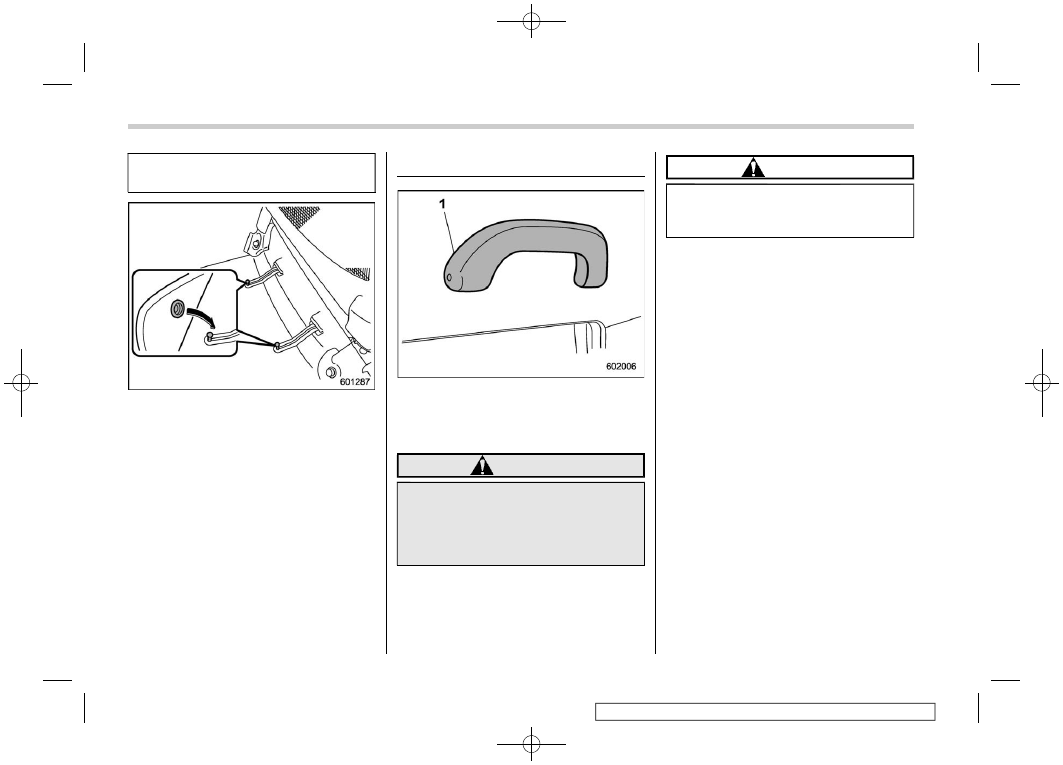
(258,1)
.
Do not use more than one floor
mat.
Retaining pins are located on the driver’s
side floor.
Properly secure the floor mat using the
built-in grommets, by placing the grom-
mets over the pins and pushing them
downward.
Assist grip
1)
Assist grip
The assist grip is to be held to support the
body of the passengers when they are in
the seat and the vehicle is moving.
WARNING
Do not hold the assist grip when
getting up from the seat. Holding
and pulling the assist grip in the
wrong way could break the grip and
possibly cause injury.
CAUTION
Do not attach heavy objects to the
assist grip. Doing so could break it
and damage the object.
Interior equipment/Assist grip
6-12

(259,1)
Coat hook
The coat hook is attached to each rear
passenger’s assist grip.
WARNING
Observe the following instructions.
.
Do not hang coat hangers or
other hard or pointed objects on
the coat hooks. Hang clothing
directly on the coat hooks with-
out using hangers.
.
Before hanging clothing on the
coat hooks, make sure there are
no pointed objects in the pock-
ets.
If these instructions are ignored, the
following may occur in sudden
stops or collisions, causing serious
injuries.
.
Items may be thrown through the
cabin.
.
SRS curtain airbags may be pre-
vented from deploying properly.
CAUTION
Never hang anything on the coat
hook that might obstruct the driver’s
view or that could cause injury in
sudden stops or in a collision. And
do not hang items on the coat hook
that weigh 11 lbs (5 kg) or more.
Under-floor storage compart-
ment
The storage compartment is located under
the floor of the trunk and can be used to
store small items. Pull the strap to open the
trunk floor lid, and then remove the lid.
NOTE
.
The shape of the storage compart-
ment may be different depending on the
model.
.
When storing a flat tire, put the
storage tray in the trunk.
CAUTION
.
Always keep the lids closed while
driving to reduce the risk of injury
– CONTINUED –
Interior equipment/Coat hook
6-13
6
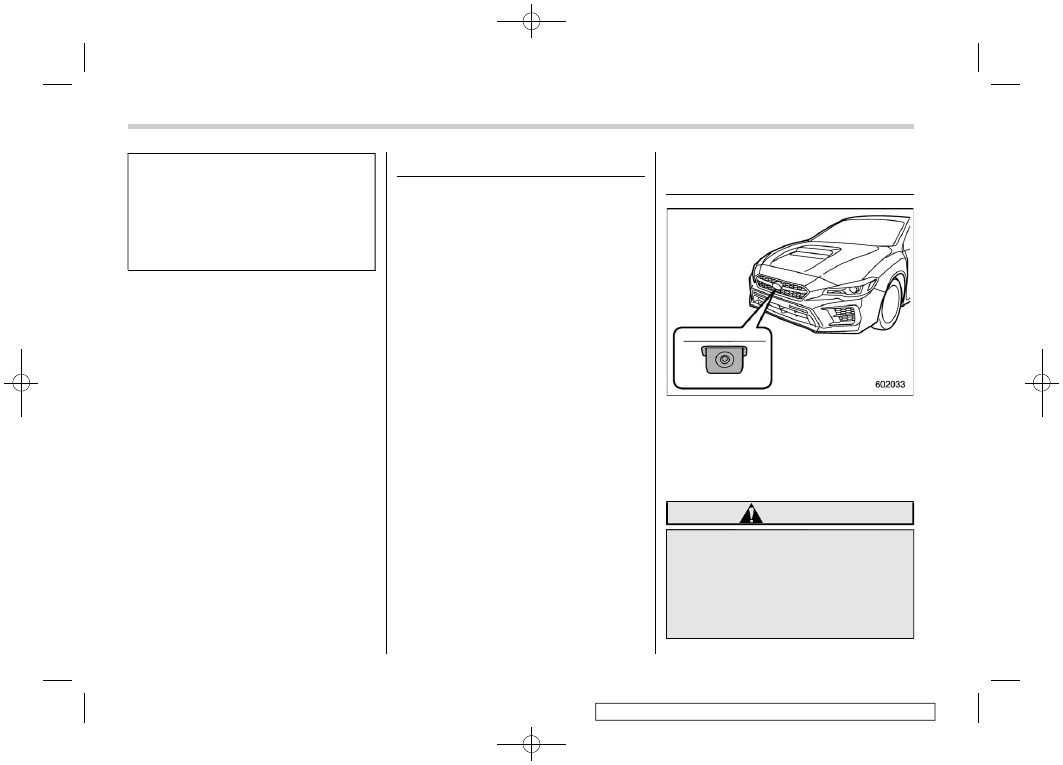
(260,1)
in the event of a sudden stop or
an accident.
.
Do not store spray cans, contain-
ers with flammable or corrosive
liquids or any other dangerous
items in the storage compart-
ment.
Rear view camera
Refer to the separate navigation/audio
Owner’s Manual.
Front View Monitor (if
equipped)
The image from the camera mounted
inside the front grille is displayed in the
multi-function display (color LCD). This
eliminates blind spots and allows the driver
to check the forward direction of both
sides.
WARNING
.
Never rely on only the Front View
Monitor when driving the vehicle.
The image on the monitor screen
may be different from the actual
situation. If you drive the vehicle
by viewing only the monitor im-
age, a collision or an unexpected
Interior equipment/Rear view camera
6-14
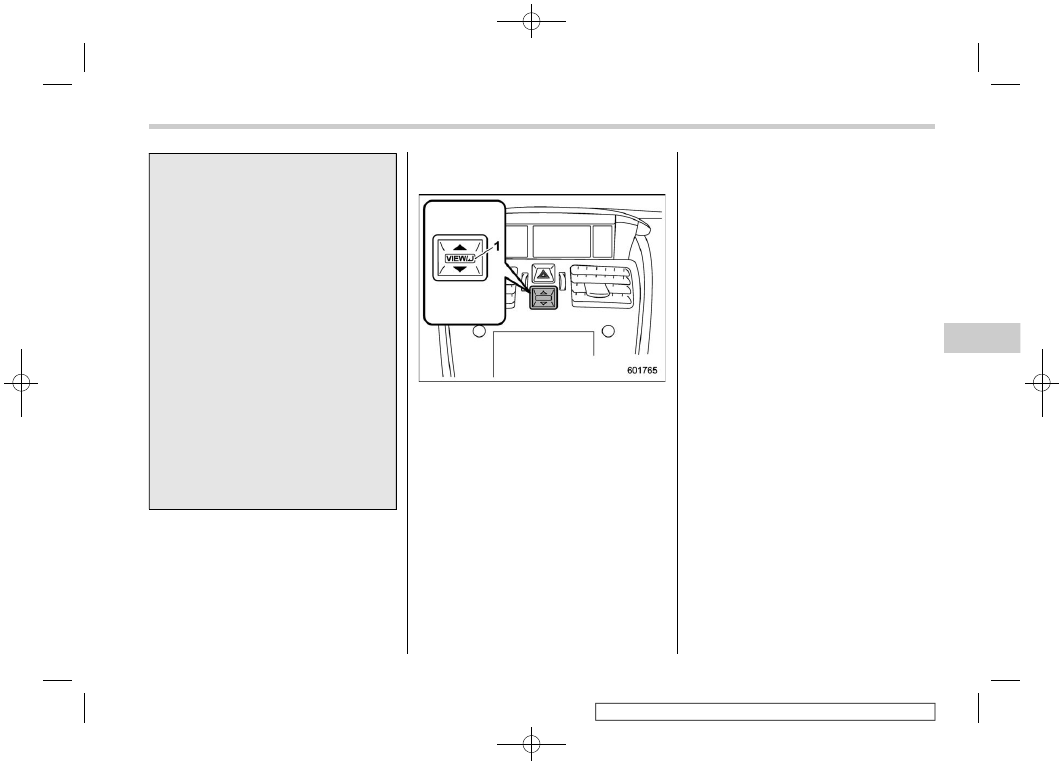
(261,1)
accident may occur. When driv-
ing the vehicle, always check the
traffic around the vehicle directly
with your eyes and the mirrors.
.
Always operate the vehicle as
you would without the Front View
Monitor.
.
Do not use the Front View Monitor
in the following situations.
– You are driving on a dirt road
or a road covered in snow.
– The camera malfunctions (e.g.
the lens or bracket is broken).
.
If the outside temperature is low,
the monitor screen may become
dark or the image may become
dim. In particular, the image of a
moving object may be distorted
or disappear from the screen.
You must always check the traffic
around the vehicle directly with
your eyes when driving it.
&
How to access the Front View
Monitor
1)
VIEW switch
To change over to the camera screen,
perform either of the following operations
when the ignition switch is in the “ON”
position.
.
Press the VIEW switch.
.
Shift the select lever from “R” to “D”
(only when the Camera Shift Link is set to
“On”) (for details, refer to “Camera shift link
setting”
&
How to cancel the Front View
Monitor
!
Manual cancellation
Press the VIEW switch again.
!
Automatic cancellation
If any of the following conditions are met,
the Front View Monitor is canceled auto-
matically.
After accessing the Front View Monitor
by pressing the VIEW switch:
.
Approximately 3 minutes have passed
since the last operation.
.
The vehicle speed becomes 12.5 mph
(20 km/h) or more.
.
The select lever (CVT models) is
shifted to the “P” position.
.
The parking brake is applied.
After accessing the Front View Monitor
by using the select lever:
.
Shift the select lever into the “P”
position.
.
The vehicle speed becomes 5 mph (8
km/h) or more.
.
Approximately 9 seconds have passed
since the last operation.
.
The parking brake is applied.
– CONTINUED –
Interior equipment/Front View Monitor
6-15
6

(262,1)
&
Range of image on screen
A)
Traffic intersection with a poor visibility
view
B)
Parking facing a wall
1)
Range of displayed image
2)
Obstacles (e.g., buildings, fences or
other vehicles)
WARNING
Because the range of the image
captured by the camera is limited,
always check the traffic around the
vehicle directly with your eyes when
driving the vehicle.
NOTE
.
The range of the displayed image
may differ depending on the vehicle
status or the road surface status.
.
Because the Front View Monitor
system uses a specially designed lens,
the sense of distance in the displayed
image is different from the actual dis-
tance.
.
The camera image may be difficult to
view in the following situations. This is
not a malfunction.
– Dark place (at night)
– High or low temperature around
the lens
– Water contacts lens or in high
humidity (rainy weather)
– There are foreign materials (such
as mud) around the camera
– Sunlight or headlight beam di-
rectly shines towards the camera
lens
.
Under an artificial light such as a
fluorescent lamp, sodium-vapor lamp
or mercury lamp, the lighted portion
may look like it is flickering (flicker
phenomenon).
.
While the display has cooled down,
the image may leave traces or become
darker than usual, causing a difficulty
in viewing the screen. Always check the
traffic around the vehicle directly with
your eyes while driving the vehicle.
.
The following incidents should not
be deemed a malfunction.
– The camera lens may become
foggy when the humidity is high on
a rainy day.
– The light from a vehicle or build-
ing located ahead may be reflected
towards the camera image while
driving at night.
– In a dark place or while driving at
night, the camera image may be
adjusted to make noises less visi-
ble. Therefore, the image may look
like a monochromatic image or the
image colors may differ from the
actual colors. The camera image
may be deteriorated in regard to
sharpness at the center and four
corners of the screen. This is not a
malfunction.
Interior equipment/Front View Monitor
6-16
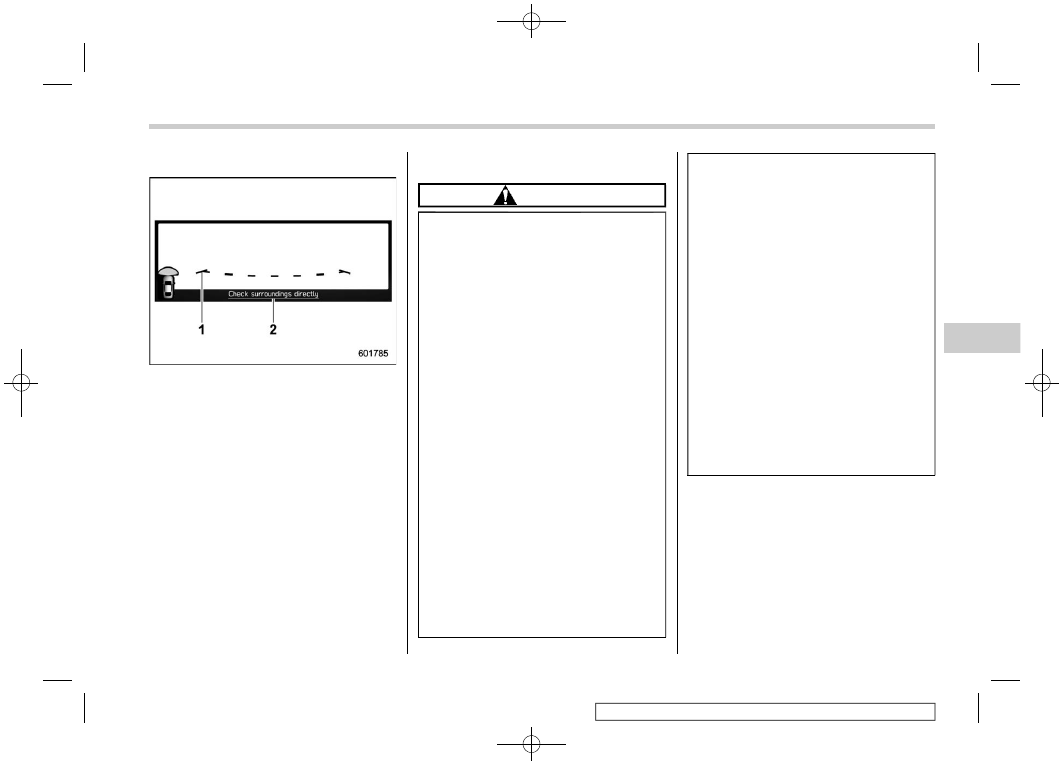
(263,1)
&
Guiding line
1)
Guiding line
2)
Warning message
The guiding line that indicates the width
and the front end of your vehicle is
displayed on the display.
&
Handling of camera
CAUTION
Observe the following instructions.
Otherwise, the system may malfunc-
tion.
.
Do not apply any strong impact to
the camera such as banging it or
hitting it with an object. The
mounting angle may change.
.
The camera unit is a waterproof
structure. Do not attempt to re-
move, disassemble or modify the
unit.
.
Do not rub strongly or polish the
camera lens with a hard brush or
abrasive compounds. The lens
may be scratched resulting in an
adverse effect to the camera
image.
.
The camera lens is made of glass
or plastic. Do not allow any
organic solvent, body wax, oil
film remover or glass coating
agent to become attached on the
lens surface. If any becomes
attached, remove it immediately.
.
Do not expose the camera lens to
any sudden temperature change,
for example, spraying hot water
on it in cold weather.
.
Do not apply the water jet of a
high pressure washer to the cam-
era or the surrounding area when
cleaning the vehicle. The impact
by the strong water pressure may
cause the camera to come off.
Also, water may enter inside the
camera and cause a malfunction.
.
If the camera is exposed to any
impact, it may lead to malfunction
of the camera. Have the camera
inspected by your SUBARU deal-
er as soon as possible.
.
Do not use a steam cleaner under
any circumstances. Some types
of steam cleaners inject hot
steam.
.
The camera surface may be da-
maged by a flying stone.
NOTE
If the camera lens is contaminated, no
sharp image is available. When the
camera is contaminated with water
drops, snow or mud, wash it with water
and wipe away any moisture with a soft
cloth. If it heavily gets dirty, wash it with
a neutral detergent.
Interior equipment/Front View Monitor
6-17
6
(265,1)
Fuel . . . . . . . . . . . . . . . . . . .. 7-3
Fuel requirements . . . . . . . . . . . . .. 7-3
Fuel filler lid and cap . . . . . . . . . . . . 7-5
State emission testing (U.S. only) . . . . . . . 7-7
Preparing to drive . . . . . . . . . . . . ... 7-8
Starting and stopping the engine . . . . . . .. 7-9
General precautions when starting/stopping
engine . . . . . . . . . . . . . . . . . 7-9
Models without push-button start systems . . . 7-10
Steering lock . . . . . . . . . . . . . . 7-11
Models with push-button start systems . . . . . 7-11
Steering lock . . . . . . . . . . . . . . 7-14
Remote engine start system (dealer option). . ... 7-14
Manual transmission . . . . . . . . . . . 7-16
Shifting speeds. . . . . . . . . . . . . . 7-17
Driving tips . . . . . . . . . . . . . . ... 7-18
Driver’s Control Center Differential
(C.DIFF/DCCD) (STI). . . . . . . . . . ... 7-19
To change mode of driver’s control center
differential . . . . . . . . . . . . . . .. 7-19
Auto mode . . . . . . . . . . . . . . . 7-20
Manual mode . . . . . . . . . . . . . . 7-21
Temporary release . . . . . . . . . . . . 7-22
Continuously variable transmission. . . . . 7-23
Select lever. . . . . . . . . . . . . . ... 7-24
Selection of manual mode. . . . . . . . . . 7-25
Shift lock function. . . . . . . . . . . . . 7-26
Driving tips . . . . . . . . . . . . . . ... 7-28
SI-DRIVE (if equipped). . . . . . . . . . .. 7-28
Intelligent (I) mode . . . . . . . . . . . . 7-28
Sport (S) mode . . . . . . . . . . . . . . 7-29
Sport Sharp (S#) mode . . . . . . . . . . . 7-29
SI-DRIVE switch. . . . . . . . . . . . . 7-30
Limited slip differential (LSD) (STI). . . . . . 7-31
Power steering. . . . . . . . . . . . . .. 7-31
STI . . . . . . . . . . . . . . . . . ... 7-31
Except STI . . . . . . . . . . . . . . . 7-31
Braking . . . . . . . . . . . . . . . . .. 7-32
Braking tips. . . . . . . . . . . . . . .. 7-32
Brake system . . . . . . . . . . . . . ... 7-33
Disc brake pad wear warning indicators. . . . 7-33
High performance brake system (Brembo
equipped models) . . . . . . . . . . . .. 7-34
ABS (Anti-lock Brake System). . . . . . . . 7-34
ABS self-check . . . . . . . . . . . . . . 7-35
ABS warning light. . . . . . . . . . . . . 7-35
Electronic Brake Force Distribution (EBD)
system . . . . . . . . . . . . . . . . 7-35
Steps to take if EBD system malfunctions. . . . 7-36
Vehicle Dynamics Control system . . . . . .. 7-37
Vehicle Dynamics Control system monitor . . . 7-38
Vehicle Dynamics Control OFF switch. . . . ... 7-38
Tire pressure monitoring system (TPMS)
(U.S.-spec. models) . . . . . . . . . . ... 7-40
Parking your vehicle . . . . . . . . . . . 7-42
Parking brake (models without electronic parking
brake system). . . . . . . . . . . . . 7-42
Electronic parking brake (models with electronic
parking brake system) . . . . . . . . . ... 7-42
Parking tips . . . . . . . . . . . . . . .. 7-45
Starting and operating
7
(266,1)
Auto Vehicle Hold function (models with
electronic parking brake system) . . . . . . 7-46
To turn on/off the Auto Vehicle Hold function . . 7-47
To operate the Auto Vehicle Hold function. . . . 7-47
To release the Auto Vehicle Hold function . . . . 7-48
Tips . . . . . . . . . . . . . . . . . .. 7-48
Hill start assist system. . . . . . . . . . . 7-49
To activate/deactivate the Hill start assist
system. . . . . . . . . . . . . . . . 7-51
Hill start assist warning light/Hill start assist OFF
indicator light (models without the electronic
parking brake system). . . . . . . . . . . 7-52
Cruise control . . . . . . . . . . . . . ... 7-53
To set cruise control . . . . . . . . . . . . 7-53
To temporarily cancel the cruise control. . . . 7-54
To turn off the cruise control. . . . . . . . . 7-55
To change the cruising speed . . . . . . . ... 7-55
Cruise control indicator . . . . . . . . . . 7-56
Cruise control set indicator . . . . . . . . ... 7-56
BSD/RCTA (if equipped) . . . . . . . . . ... 7-56
System features . . . . . . . . . . . . . 7-57
System operation. . . . . . . . . . . . .. 7-59
BSD/RCTA approach indicator light/warning
buzzer . . . . . . . . . . . . . . . ... 7-60
BSD/RCTA OFF indicator . . . . . . . . . .. 7-62
BSD/RCTA warning indicator . . . . . . . . 7-62
BSD/RCTA OFF switch. . . . . . . . . . .. 7-63
Certification for the BSD/RCTA . . . . . . . . 7-63
Handling of radar sensors . . . . . . . . . 7-65
Reverse Automatic Braking (RAB) system
(if equipped) . . . . . . . . . . . . . ... 7-66
Reverse Automatic Braking (RAB) system
overview. . . . . . . . . . . . . . . 7-66
Operating conditions . . . . . . . . . . . 7-68
Reverse Automatic Braking (RAB) system
operation. . . . . . . . . . . . . . ... 7-70
Canceling the Reverse Automatic Braking (RAB)
system operation. . . . . . . . . . . ... 7-74
Reverse Automatic Braking (RAB) system
ON/OFF setting. . . . . . . . . . . . .. 7-74
RAB warning indicator. . . . . . . . . . .. 7-75
Handling of the sonar sensors . . . . . . . .. 7-75
Starting and operating
(267,1)
Fuel
CAUTION
Use of a fuel which is low in quality
or use of an inappropriate fuel
additive may cause engine damage.
&
Fuel requirements
!
STI
The engine is designed to operate at
maximum performance using
unleaded
gasoline
with an octane rating of
93 AKI
(98 RON) or higher
. If 93 AKI (98 RON)
fuel is not readily available in your area,
unleaded gasoline with an octane rating of
91 AKI (95 RON) may be used with no
detriment to engine durability or driveabil-
ity. However, you may notice a slight
decrease in maximum engine perfor-
mance while using 91 AKI (95 RON) fuel.
Use of 91 AKI (95 RON) fuel will not affect
your warranty coverage.
!
Except STI
The engine is designed to operate using
unleaded gasoline
with an octane rating
of
91 AKI (95 RON) or higher
. If 91 AKI
(95 RON) fuel is not readily available,
unleaded gasoline with an octane rating of
87 AKI (90 RON) may be used.
Regular unleaded gasoline with an octane
rating of 87 AKI (90 RON) or higher may
also be used. Using regular unleaded
gasoline will not be detrimental to engine
durability, nor will it affect your warranty
coverage. However, depending on your
driving habits and conditions, you may
notice a decrease in maximum engine
performance, fuel economy or slight en-
gine vibration or knocking. If you experi-
ence any of these conditions while using a
lower octane rated fuel, you may want to
return to using 91 AKI (95 RON) octane
rated fuel as soon as possible. Addition-
ally, if your vehicle knocks heavily or
persistently, the use of 91 AKI (95 RON)
or higher grade unleaded gasoline is
required.
!
Fuel octane rating
Using a gasoline with a lower octane rating
can cause persistent and heavy knocking,
which can damage the engine. Do not be
concerned if your vehicle sometimes
knocks lightly when you drive up a hill or
when you accelerate. Contact your
SUBARU dealer if you use a fuel with the
specified octane rating and your vehicle
knocks heavily or persistently.
!
RON
This octane rating is the Research Octane
Number.
!
AKI
This octane rating is the average of the
Research Octane and Motor Octane num-
bers and is commonly referred to as the
Anti Knock Index (AKI).
!
Unleaded gasoline
The neck of the fuel filler pipe is designed
to accept only an unleaded gasoline filler
nozzle. Under no circumstances should
leaded gasoline be used because it will
damage the emission control system and
may impair driveability and fuel economy.
!
Reformulated gasoline
SUBARU supports the use of reformulated
gasoline when available. Reformulated
gasoline has been blended to burn more
cleanly and reduce vehicle emissions.
– CONTINUED –
Starting and operating/Fuel
7-3
7
(268,1)
!
MMT
Some gasoline contains an octane-enhan-
cing additive called MMT (Methylcyclo-
pentadienyl Manganese Tricarbonyl). If
you use such fuels, your emission control
system performance may deteriorate and
the CHECK ENGINE warning light/Mal-
function indicator light may turn on. If this
happens, return to your authorized
SUBARU Dealer for service. If it is
determined that the condition is caused
by the type of fuel used, repairs may not be
covered by your warranty.
!
Gasoline for cleaner air
Your use of gasoline with detergent ad-
ditives will help prevent deposits from
forming in your engine and fuel system.
This helps keep your engine in tune and
your emission control system working
properly, and is a way of doing your part
for cleaner air. If you continuously use a
high quality fuel with the proper detergent
and other additives, you should never
need to add any fuel system cleaning
agents to your fuel tank.
Many gasolines are now blended with
materials called oxygenates. Use of these
fuels can also help keep the air cleaner.
Oxygenated blend fuels, such as ethanol
(ethyl or grain alcohol) may be used in your
vehicle, but should contain no more than
10% ethanol for the proper operation of
your SUBARU.
Do not use any gasoline that contains
more than 10% ethanol, including from any
pump labeled E15, E30, E50 or E85 (which
are only some examples of fuel containing
more than 10% ethanol).
In addition, some gasoline suppliers are
now producing reformulated gasolines,
which are designed to reduce vehicle
emissions. SUBARU approves the use of
reformulated gasoline.
If you are not sure what the fuel contains,
you should ask your service station op-
erators if their gasolines contain deter-
gents and oxygenates and if they have
been reformulated to reduce vehicle emis-
sions.
As additional guidance, only use fuels
suited for your vehicle as explained in the
following description.
.
Fuel should be unleaded and have an
octane rating no lower than that specified
in this manual.
.
Methanol (methyl or wood alcohol) is
sometimes mixed with unleaded gasoline.
Methanol can be used in your vehicle
ONLY
if it does not exceed 5% of the fuel
mixture
AND
if it is accompanied by
sufficient quantities of the proper cosol-
vents and corrosion inhibitors required to
prevent damage to the fuel system. Do not
use fuel containing methanol
EXCEPT
under these conditions.
.
If undesirable driveability problems are
experienced and you suspect they may be
fuel related, try a different brand of gaso-
line before seeking service at your
SUBARU dealer.
.
Fuel system damage or driveability
problems which result from the use of
improper fuel are not covered under the
SUBARU Limited Warranty.
CAUTION
Do not let fuel spill on the exterior
surfaces of the vehicle. Fuels con-
taining alcohol may cause paint
damage, which is not covered under
the SUBARU Limited Warranty.
Starting and operating/Fuel
7-4

Нет комментариевНе стесняйтесь поделиться с нами вашим ценным мнением.
Текст